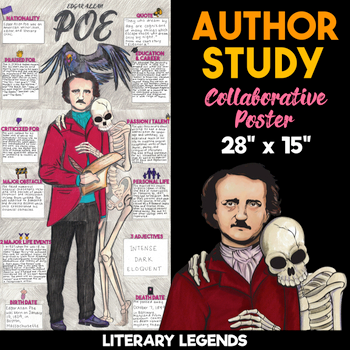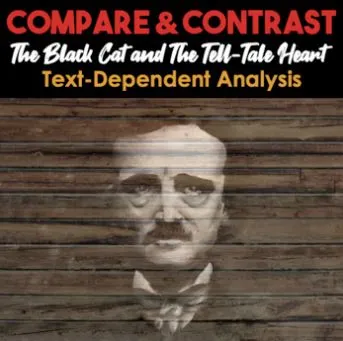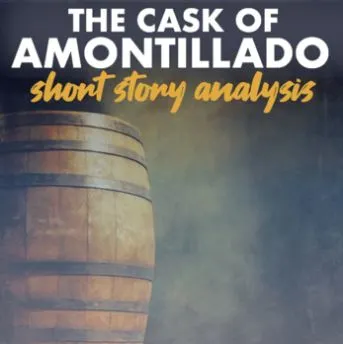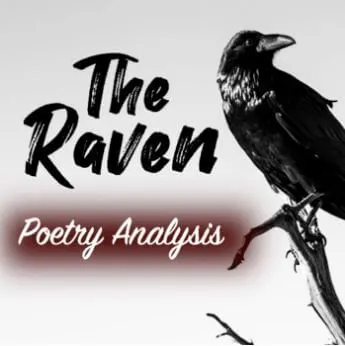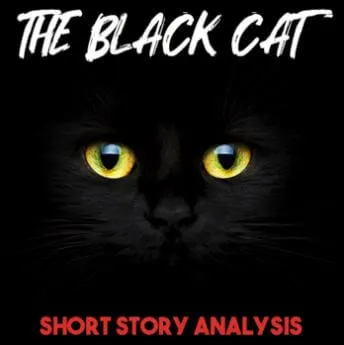To be great, one should “study the greats.” And so, to inspire greatness, one should “teach the greats.”
Works of literature are vital tools for improving a student’s language arts skills. They serve as models that naturally reinforce spelling, vocabulary, grammar, writing mechanics, reading comprehension, and creative writing. For this reason, it makes sense to instruct using masters of the craft in the classroom. One such important and influential American master is Edgar Allan Poe.
Poe was a writer, poet, editor, and literary critic. He is best known for his poetry and short stories, particularly his tales of mystery and horror.
Poe was not just an author, but a literary inventor. He is credited with introducing aspects of mystery writing that are now considered classic elements of detective fiction. His works are definitive examples of the art and craft of writing, making them the perfect tools for teaching writing skills and reading comprehension.
The Best Poe Stories to Teach…
The Tell-Tale Heart Lesson Plans
Your students are going to love deciphering and solving puzzles in this creepy, 360° digital escape room. This activity is designed to work for a laptop, tablet, or smart phone. Students will solve a series of clues based on the story “The Tell-Tale Heart” by Edgar Allan Poe in order to crack the master lock and escape the room. This game entails reading comprehension skills, finding textual evidence, and making inferences.
This reading guide for “The Tell-Tale Heart” by Edgar Allan Poe includes an anticipation guide for students to complete before reading, comprehension/recall questions for during reading, and literary analysis, text-dependent questions for after reading.
Students will analyze:
- point of view
- unreliable narrator
- mood
- suspense
- motives
- author’s language
Answer key included as well as an EDITABLE copy for teachers.
Guilty or not guilty?! Let your students decide the fate of the narrator from The Tell-Tale Heart!
This activity requires research, critical thinking, close reading, literary analysis, and finding textual evidence to justify responses. Students will research the different degrees of murder in the United States. Then they will take on the role of the judge for the trial against the narrator in the story “The Tell-Tale Heart” by Edgar Allan Poe.
Students will use both critical thinking skills and evidence from the story to decide if the murder was premeditated, if there was motive, and if there is enough evidence that supports a plea of insanity by the narrator. Once students come to a decision, guilty or not guilty, they will then decide an appropriate punishment for the defendant.
This resource includes:
- Research guide for students to follow (PDF)
- Direct connection between the research and the short story (PDF)
- Questions about the story that require textual evidence (PDF)
- Editable copy for teachers (word document)
- Answer guide for teachers (PDF)
This is a great way to end the unit of “The Tell-Tale Heart” or it could be used as a prewriting activity for an argumentative essay on the same topic.
Reading Paired Texts: Text-Dependent Analysis and Response To Literature Essay for The Tell-Tale Heart and The Black Cat by Edgar Allan Poe.
If you are looking for a pair of awesome texts with similar themes, topics, and literary elements, this product features a compare and contrast chart for the two gothic tales by Edgar Allan Poe “The Tell-Tale Heart” and “The Black Cat.”
Both feature unreliable narrators who commit heinous crimes. Both narrators claim not to be mad, but are they telling the truth? Both stories are also filled with horror, suspense, and evil. Comparing these two stories is great practice for writing a TDA.
Included in this purchase is:
- a graphic organizer that outlines how students will compare multiple literary elements of the two short stories.
- the response to literature (RTL) essay or text-dependent analysis (TDA) prompt for students and a rubric with point values based on Common Core Standards.
- an answer guide to the literary analyses of both texts.
Student Objectives:
- Analyze how two texts from the same author treat similar themes or topics.
- Compare and contrast the structure of two or more texts and analyze how the differing structure of each text contributes to its meaning and style.
- Cite strong and thorough textual evidence to support analysis of what the text says explicitly, as well as inferences and conclusions based on and related to an author’s implicit and explicit assumptions and beliefs.
- Draw evidence from literary texts to support analysis, reflection, and research.
- Students will analyze important literary devices including: plot, conflicts, themes, characters, point of view, text structure, mood, tone, and symbolism.
The Cask of Amontillado Lesson Plans
Your students are going to love deciphering and solving puzzles in this ominous, 360° digital escape room. This activity is designed to work for a laptop, tablet, or smart phone. Students will solve a series of clues based on the story “The Cask of Amontillado” by Edgar Allan Poe in order to crack the master lock and escape the room. This game entails reading comprehension skills, finding textual evidence, and making inferences.
Included in this download are teacher instructions, student instructions (digital), the master lock graphic organizer, answer keys, and a reflection sheet (optional).
One of Edgar Allan Poe’s most popular sinister tales is The Cask of Amontillado. In this literary short story analysis, students will define academic vocabulary from the story, participate in an anticipation activity, be given a brief background on Carnival of Venice, answer reading comprehension questions, write a quick summary, and play a fun “would you rather” game based on details of the story. Answer keys are included! This story is perfect for learning the three types of irony: situational, verbal, and dramatic as well as character motivations, theme, dialogue, suspense, and mood.
The Fall of the House of Usher Lesson Plans
Your students are going to love deciphering and solving puzzles in this creepy and suspenseful 360° digital escape room. Students must escape the house of Usher before the whole mansion collapses on them!
This activity is designed to work for a laptop, tablet, or smart phone. Students will solve a series of clues based on the story “The Fall of the House of Usher”by Edgar Allan Poe in order to crack the master lock and escape the room. This game requires reading comprehension skills; students must find textual evidence to solve the puzzles. Watch the video preview to get a closer look at the clues and the room.
Included in this download are teacher instructions, student instructions (digital), the master lock graphic organizer, answer keys, and a reflection sheet (optional).
This product is for Edgar Allan Poe’s “The Fall of the House of Usher” and consists of reading comprehension questions and a gothic literature analysis graphic organizer.
1) To activate students’ prior knowledge on gothic literature, students will participate in a carousel brainstorming activity.
2) Students will define academic vocabulary for the short story “The Fall of the House of Usher.”
3) Students will read the full story “The Fall of the House of Usher” by Edgar Allan Poe and complete the reading comprehension questions.
4) Students will analyze the literature after reading. Using textual evidence, students will fill out a graphic organizer identifying and explaining gothic motifs and elements in “The Fall of the House of Usher.”
5) Answer keys provided.
The Raven Lesson Plans
Your students are going to love The Raven Digital Escape Room! Students will read and analyze the poem “The Raven” by Edgar Allan Poe.
They will solve 6 puzzles in this 360° ominous, dark, room,—of course with a spooky raven perched inside. Check out the video preview to get a sneak peek of the room!
This activity is designed to work for a laptop, tablet, or smart phone. This game requires reading comprehension strategies, knowledge of poetic devices, and critical thinking skills.
Included in this purchase are: teacher instructions, student instructions (digital), the master lock graphic organizer, answer guides, the full text of the poem, and a reflection sheet (optional).
This resource includes a copy of the poem “The Raven” by Edgar Allan Poe and 26 close reading questions. The analysis includes an in-depth look at academic vocabulary, poetic devices, and literary elements in the poem. (An answer key is also provided.)
Poetic and Literary Devices Covered in this Activity:
- allusion
- alliteration
- symbolism
- rhyme scheme
- repetition
- mood
- tone
- imagery
- gothic literature
- theme
The Masque of the Red Death Lesson Plans
Your students are going to love deciphering and solving puzzles in this creepy, dark, and suspenseful 360° digital escape room. Students must escape the black chamber before the Red Death can get them!
This activity is designed to work for a laptop, tablet, or smart phone. Students will solve a series of clues based on the story “The Masque of the Red Death” by Edgar Allan Poe in order to crack the master lock and escape the room. This game entails reading comprehension skills, finding textual evidence, and making inferences. Watch the video preview to get a closer look!
Included in this download are teacher instructions, student instructions (digital), the master lock graphic organizer, answer keys, and a reflection sheet (optional).
Have your students read the foreboding, gothic short story “The Masque of the Red Death” by Edgar Allan Poe with this Close Reading and Analysis activity! This product includes the short story, side by side with questions to annotate/analyze the literature as well as define academic vocabulary.
Included in this literary analysis:
- before reading activity on color meanings
- before reading journal activity
- full text “The Masque of the Red Death” by Edgar Allan Poe
- vocabulary terms to define
- reading comprehension questions
- after reading analysis questions, with a focus on allegory and symbolism
- objective summary prompt
- answer keys
The Black Cat Lesson Plans
Have your students read the creepy, gothic short story “The Black Cat” by Edgar Allan Poe and supplement your lesson with these pre-reading, during reading, and after reading activities!
First have your students look at a series of superstitions and decide if they are superstitious themselves.
Secondly, this story is RICH with academic vocabulary. Have your students choose 10 words from a list of 25 words to learn and define.
Next, your students will read the short story “The Black Cat” by Edgar Allan Poe and answer 25 questions that require literary analysis and the use of textual evidence.
Have your students dive further into the short story with a quote analysis activity and direct students to breakdown the significance of important quotes from the story.
To summarize this lesson, have your students write an objective summary of the text; lastly, they will choose one of three fun, creative writing options from a learning menu.
Literary elements covered in this lesson include foreshadowing, suspense, irony, point of view, character motives, and theme.
Reading Paired Texts: Text-Dependent Analysis and Response To Literature Essay for The Tell-Tale Heart and The Black Cat by Edgar Allan Poe.
If you are looking for a pair of awesome texts with similar themes, topics, and literary elements, this product features a compare and contrast chart for the two gothic tales by Edgar Allan Poe “The Tell-Tale Heart” and “The Black Cat.”
Both feature unreliable narrators who commit heinous crimes. Both narrators claim not to be mad, but are they telling the truth? Both stories are also filled with horror, suspense, and evil. Comparing these two stories is great practice for writing a TDA.
Included in this purchase is:
- a graphic organizer that outlines how students will compare multiple literary elements of the two short stories.
- the response to literature (RTL) essay or text-dependent analysis (TDA) prompt for students and a rubric with point values based on Common Core Standards.
- an answer guide to the literary analyses of both texts.
Student Objectives:
- Analyze how two texts from the same author treat similar themes or topics.
- Compare and contrast the structure of two or more texts and analyze how the differing structure of each text contributes to its meaning and style.
- Cite strong and thorough textual evidence to support analysis of what the text says explicitly, as well as inferences and conclusions based on and related to an author’s implicit and explicit assumptions and beliefs.
- Draw evidence from literary texts to support analysis, reflection, and research.
- Students will analyze important literary devices including: plot, conflicts, themes, characters, point of view, text structure, mood, tone, and symbolism.
Literary Elements to Cover
Literary elements create meaning and convey that meaning to readers. Developing a solid understanding of a story’s elements is essential for students to follow and fully comprehend what they’re reading. It also helps kids become intentional about how they craft their thoughts into words once it comes time to write.
So, the most effective way to teach literary elements is to show students how those elements work to create meaning within a given text. One major literary element used to drive meaning in Poe’s works is mood.
Poe has been referred to as the “Master of Mood.” Using “The Raven” as an example, Poe implements descriptions and descriptive words, such as “midnight dreary” and “bleak December,” to create a doomy and ominous atmosphere. A good exercise is to have students circle or underline any “mood” words they can find.
Another element in almost all of Poe’s works is suspense. In “The Tell-Tale Heart,” Poe creates suspense through first-person narration with an unreliable narrator. This technique present readers with the opportunity to make their own interpretations. Poe builds suspense further through carefully timing his plot events.
Poe also uses irony to make the tension in his stories stronger and more intense. For example, in “The Cask of Amontillado,” the reader knows Montresor despises Fortunato and plans his demise. However, Fortunato is ignorant of this fact, and his ignorance proves fatal to him. To get specific, this is an example of dramatic irony because the readers are aware of something that characters in the story are not.
Figurative language is another element that makes Poe’s works so masterful. Metaphor, personification, allusion, simile—these elements are interpretive tools for the reader to use and they bring richness and coherence to a text.
Best Tactics for Struggling Readers
Poe was a literary genius, and his texts can be challenging to read. When appropriate, there are simplified and abbreviated versions of Poe’s works for struggling readers.
Otherwise, it may be helpful to give struggling readers more context before reading. The Academy of American Poets recommends warming students up with an illustration of the poem. Effective readers often “see” a story in their mind.
It may also be helpful to share relevant information for context. In the case of “The Raven,” the AAP recommends the article “10 Fascinating Facts About Ravens.” Such a resource gives students an alternate entry point into the poem, as well as practice with noticing visual details.
It’s also helpful to struggling readers if teachers synthesize information along the way. This means looking distinctly for related words, concepts, and ideas in the text and using them to form a main idea or summary statement. Since Poe makes such heavy use of literary elements like mood, his works are perfect for this exercise.
Enrichment Ideas for the Gifted Classroom
Poe’s life and works present infinite opportunities for enrichment activities for more skillful students.
The imitation assignment is a good one. Imitating the writing of others can help students enhance their own writing. Have students write their own poems, taking Poe’s as a model. The goal is to substitute different subject matter while still trying to imitate the exact grammatical structures, lengths and rhythms of the sentences, and the tones of the original.
Student poems don’t need to be the same length as Poe’s. However, they should be long enough to incorporate important elements of Poe’s, such as the refrain, which he deemed key to poetic effect. Students should of course indicate which poem they are imitating.
Another enrichment idea is writing the prequel to a piece of Poe’s, such as “The Raven.” Have students explore what they think happened to Lenore, or have students write a sequel to the poem whereby they explore what happens next.
The narrator’s unknown fate in “The Tell-Tale Heart” makes for the perfect mock trial with gifted students. Should the narrator be charged with first degree murder? Should he be found not guilty by plea of insanity? Have your students be the judge and jury to decide.
Growing with popularity today are digital escape rooms. Have your students participate individually or collaboratively in groups to solve clues in a creepy, eerie Poe-themed escape room. Students love the technology aspect as well as the adventure game feel.

